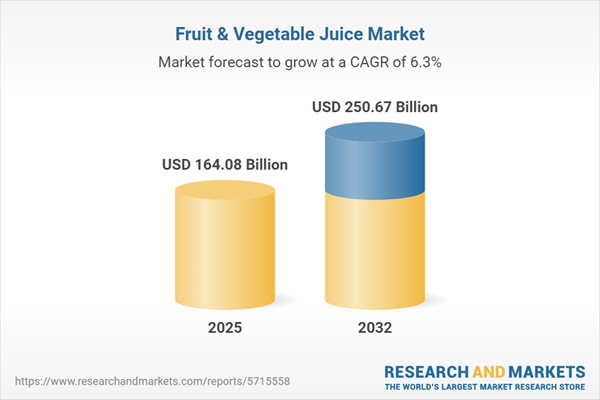Speak directly to the analyst to clarify any post sales queries you may have.
The global fruit and vegetable juice market is experiencing rapid transformation, shaped by innovation, evolving consumer expectations, and stricter regulatory oversight. Senior decision-makers need reliable market intelligence to identify emerging growth paths and manage strategic responses in a fast-moving sector.
Fruit and Vegetable Juice Market Snapshot
The fruit and vegetable juice market continues to evolve as shifting consumer preferences and regulatory expectations influence business operations. Heightened health awareness is fueling the demand for clean-label products and beverages with transparent functional benefits. This drives an industry-wide focus on operational agility and responsiveness, underpinned by secure and adaptable supply chains. Market leaders are deploying real-time analytics to reinforce business continuity, address regulatory changes, and preserve brand equity. Senior executives are adjusting portfolio strategies to ensure competitiveness and resilience in a dynamic environment.
Scope & Segmentation of the Fruit and Vegetable Juice Market
- Product Types: Single-fruit juice variants like apple, grape, and orange play a crucial role in meeting established preferences, while blends incorporating ingredients such as carrot, spinach, and tomato address broader nutritional demands and attract a wider range of consumers.
- Packaging Formats: Bottles, cans, cartons, and pouches align with safety requirements, grab-and-go convenience, and expanding environmental initiatives in packaging, illustrating how sustainability and consumer expectations intersect.
- Distribution Channels: Supermarkets, hypermarkets, convenience stores, and online marketplaces provide broad coverage and accessibility, connecting brands to varying demographic and regional markets and supporting expansion strategies.
- Packaging Sizes: Small-size packages under 200 ml cater to mobile lifestyles and impulse purchases, while intermediate 200–500 ml formats and larger family-sized packages adapt to modern consumption needs and efficient supply planning.
- Production Techniques: Techniques such as cold pressing, high pressure processing, and pasteurization support food safety, improve nutrition retention, and elevate process efficiency, providing critical points of differentiation and compliance.
- Geographic Regions: The Americas, Europe, Middle East & Africa, and Asia-Pacific each present region-specific regulatory conditions, consumer preferences, and strategic imperatives, calling for distinct engagement and execution tactics.
- Key Companies: PepsiCo, The Coca-Cola Company, Nestlé, Danone, Fresh Del Monte Produce, Conagra Brands, Campbell Soup Company, Ocean Spray Cranberries, Keurig Dr Pepper, and Welch Foods continue to shape global standards and innovate to sustain competitive advantage.
Key Takeaways for Senior Decision-Makers
- Adopting clean-label formulations and functional ingredients positions portfolios to capitalize on heightened consumer wellness trends, supporting lasting loyalty and competitive differentiation.
- Investing in circular packaging systems and enhanced traceability frameworks addresses both sustainability goals and dynamic regulatory requirements across regions, while improving supply chain integrity.
- Integrating automation into manufacturing and leveraging smart packaging improves operational efficiency, provides real-time data, and enables agile responses to rapid shifts in demand or regulations.
- Strategic collaboration, such as M&A and joint ventures, facilitates effective portfolio expansion and provides resilience when navigating evolving market landscapes and heightened competition.
- Regional market dynamics vary, with the Americas focusing on health-centric and convenient offerings, Europe emphasizing organic sourcing and transparent labeling, and Asia-Pacific advancing in functional beverages and technology integration.
Tariff Impact: Navigating Policy Shifts
Recent adjustments to U.S. tariffs on imported fruit and vegetable juices are prompting many companies to revisit sourcing and distribution plans. Local procurement and proactive risk management now receive greater emphasis as industry best practices. Senior leadership is encouraged to strengthen internal expertise and organizational structures to maintain end-to-end supply chain resilience and compliance amid ongoing policy adjustments.
Fruit and Vegetable Juice Market Methodology & Data Sources
This report synthesizes robust secondary research, in-depth interviews with industry specialists, and advanced quantitative modeling. The blended approach ensures that analysis remains objective and supports adaptation amid marketplace volatility for fruit and vegetable juice stakeholders.
Why This Report Matters for Senior Decision-Makers
- Provides frameworks that allow executives to identify high-potential segments, informing capital allocation and supporting targeted, sustainable growth as regulatory and market demands shift.
- Examines how digital transformation and operational agility enable organizations to respond effectively and ahead of emerging industry and regulatory changes.
- Supports strategic risk management integration and long-term business planning, ensuring enhanced competitive positioning in a complex, international marketplace.
Conclusion
With the insights presented in this report, executives can implement strategies to address volatility, advance organizational resilience, and maintain strong industry positioning as fruit and vegetable juice markets evolve worldwide.
Additional Product Information:
- Purchase of this report includes 1 year online access with quarterly updates.
- This report can be updated on request. Please contact our Customer Experience team using the Ask a Question widget on our website.
Table of Contents
3. Executive Summary
4. Market Overview
7. Cumulative Impact of Artificial Intelligence 2025
Companies Mentioned
The companies profiled in this Fruit & Vegetable Juice market report include:- PepsiCo, Inc.
- The Coca-Cola Company
- Nestlé S.A.
- Danone S.A.
- Fresh Del Monte Produce Inc.
- Conagra Brands, Inc.
- Campbell Soup Company
- Ocean Spray Cranberries, Inc.
- Keurig Dr Pepper Inc.
- Welch Foods Inc.
Table Information
| Report Attribute | Details |
|---|---|
| No. of Pages | 194 |
| Published | October 2025 |
| Forecast Period | 2025 - 2032 |
| Estimated Market Value ( USD | $ 164.08 Billion |
| Forecasted Market Value ( USD | $ 250.67 Billion |
| Compound Annual Growth Rate | 6.2% |
| Regions Covered | Global |
| No. of Companies Mentioned | 11 |









